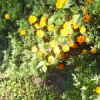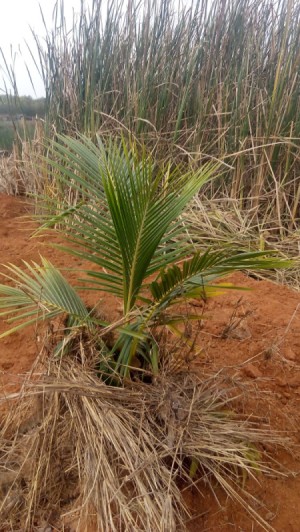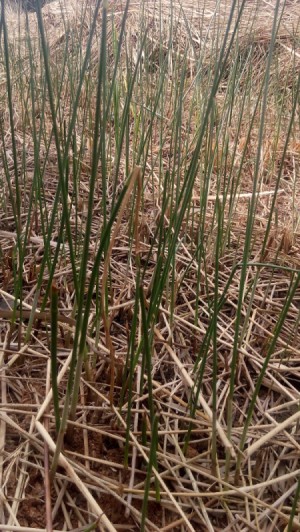I am a farmer; I have 12 acres of land. My land is salty and the water is also salty. Can someone please suggest to me which type of fruit production I can attempt on my land? I am located in Maharashtra, Jalgaon City.
By Gajendra from India
Add your voice! Click below to answer. ThriftyFun is powered by your wisdom!

I do not know of anything that will grow in salty soil, call your County extension office for more info. Citrus will grow in most soils that are moist but well drained. Avoid salty soils. Good luck.
I am not sure what would work for you but the ones who might would be the Israeli's. If you can find some sites for Plant/Garden Nurseries in Israel they might be able to point you towards both plants and information since I believe they have done very well under same circumstances. I'll scout around and see if I can find any information here; you might check Florida Dept.
Also I don't know how much water you have access to but you could look into fish farming possibly.
Once my mind gets going, it doesn't stop. See if you can find permaculture organizations in India. I know they exist, if anyone would have a clue, they would.
I found this article that might help you. It talks about a variety of Sea Kale and Sugar Beets that can grow in salty soil. Good luck!
Dutch Sea Kale Grown in Salty Soil Offers Peek at Food Future Share Business
Dec. 5 (Bloomberg) -- At Jef Schuur's restaurant on the Dutch resort island of Texel, guests dig in with gusto to an unusual vegetable grown in the salty soil next to the North Sea.
Sea kale, a leafy plant with white stalks that's fried up with olive oil, surprises customers with its pleasantly nutty taste, said Schuur, who has served the dish for the past year. The plant, related to kale and Chinese cabbage, grows wild on Texel and was recently domesticated by biologists trying to find crops able to adapt to saltier growing conditions stemming from global warming.
"It has a stronger flavor than most vegetables but brings out very nice accents in food,
" Schuur said. "Growing sea kale here shows that there are a lot more opportunities for local produce on low-lying islands affected by salt."
In the Netherlands, where a quarter of the country lies below sea level, 150,000 hectares (370,000 acres) of agricultural land is at risk as soils become saltier from rising sea levels and more intense storms wash additional salt water on shore. By cultivating plants that can grow in such degraded soil or where little fresh water is available, farmers around the world can expand cropland, helping to limit soaring food prices and adapt to climate change.
Global warming is melting polar caps, raising sea levels in some parts of the world and inundating coastal farmland while in other regions climate changes have reduced rainfall, making soil more alkaline. By finding plants that thrive in saltier waters, farmers can better adapt to drought and sometimes irrigate with sea water, which makes up 98 percent of Earth's water resources.
Real Urgency
"There's a real urgency to addressing the issue of rising food and fuel prices," Jelte Rozema, a researcher at Amsterdam's Free University, said in an interview. "You can bring barren land back into cultivation by expanding saline agriculture."
Earlier this year, prices for staple foods reached records as production of biofuels, manufactured largely with corn, soared. The World Bank in March warned that civil disturbances may be triggered by rising food prices in more than 30 countries.
The failure of biotechnology to genetically alter the world's main crops of wheat, rice and corn to be more salt-tolerant is leading to a wave of projects that focus on about 1,000 species that grow well in saline soils, said Tim Flowers, a researcher at the University of Sussex who co-wrote a report with Rozema published in this week's edition of Science.
Pressure on freshwater resources, which make up 1 percent of the world's total water supply, is increasing as the global population is expected to rise to 9.3 billion people by 2050 from 6.7 billion now, according to UN estimates. As aquifers and rivers dry up in regions like the southwestern U.S., India and the Middle East, soils are being destroyed by higher salt levels.
Saline Agriculture
"Certainly saline agriculture can play a role in supplying the world with additional resources for food and fuel," Neville Ash, head of International Union for Conservation of Nature's Ecosystem Management Program in Switzerland, said in an interview. "But prevention is always the best method. In many cases there is a complete lack of awareness of what can happen to soils if crops are irrigated improperly."
Rising sea levels in coastal areas are also rendering soils infertile as salt water inundates low-lying farmland. Coastal deserts, farmland damaged by drawing too much groundwater and arid regions with salty brackish water, which is available in equal quantities as fresh water, are also suitable for salt-tolerant vegetation.
All plants evolved in salt water 3 billion years ago and most lost their ability to grow in soils or water with high concentrations of sodium and chlorine, the two elements that form salt, about 450 million years ago, the Rozema and Flower study said. Only about 1 percent of land-based plants, including beets, dates and pomegranate, can grow in salt-rich environments.
Swiss Sugar Beet
Syngenta AG, a Swiss seed developer, has developed a sugar beet for use in tropical countries that can grow in salty soil damaged by sugar-cane plantations. The plant was introduced last year on farms in India, said company spokeswoman Sabine Hoffmann.
Other research has led to crossing wild tomatoes grown near the shoreline on the Galapagos Islands with commercial varieties that yield an edible fruit and can be cultivated using 70 percent seawater.
Seeds of eelgrass, which grows fully submerged in the Pacific Ocean off California, were eaten by local indigenous people and can be ground into flour to make bread.
The most promising use of salt-tolerant plants are those that produce seeds or could generate biomass for making plant-based fuels, Rozema and Flowers said.
Shifting peoples food preferences would also help reduce pressure on water supply as researchers domesticate more varieties of halophytes, plants whose growth is improved with low levels of salt, for human use and consumption, they added.
On Texel, a Frisian Island 100 miles (160 kilometers) north of Amsterdam, Schuur said he'd gladly cook with more vegetables grown locally in salty soils. "These are interesting products and people like to try something new."
To contact the reporter on this story: Jeremy van Loon in Berlin at jvanloon@bloomberg.net
Last Updated: December 4, 2008 21:25 EST
Grow guavas they can be grown in saline areas. We grow them here in Kohat, Pakistan. You'll need good quality seeds though.
Can you sell me seeds of the guava?
I live in a salty land environment, it was very difficult for me to grow anything at all in my plot of land. However I see palm trees all around, therefore I tried a dwalf coconut last year, The coconut is growing beautifully now but I can not talk about the yield since it's just a year, but all the palm trees I sees around are growing well despite the fact that nobody is taken care of them.
As far as the salt water do not get to the stem of the plants they are doing great. The first coconut I planted died when the area was flooded with the salt water as it was just germinating then, but this new one I make sure the water can not get to its leaves.
So from my experience you can grow palm trees and coconut in your land as those palm trees in my area are growing well on the salty land without care.
Also mart leave( a monocotyledons grass using in making mart in africa) thrive so well on the land around ( the leaves looks like rice) therefore you can experiment rice on a small portion but make sure you grow it nursery before transplanting it . good luck



Dear Gajendra ji,
I have gone through your query and found interesting. Before giving any suggestion, I would like to know the salinity status of the soils and irrigation water of your farm. If you have not got tested the same, please get it done and inform me. Having worked with saalinity and fruit crops, I would like to give some inputs in your case. Contact me on ggrao54@yahoo.com.
You can grow easly salgam but should be difference in trees then you grow in your farm
Add your voice! Click below to answer. ThriftyFun is powered by your wisdom!